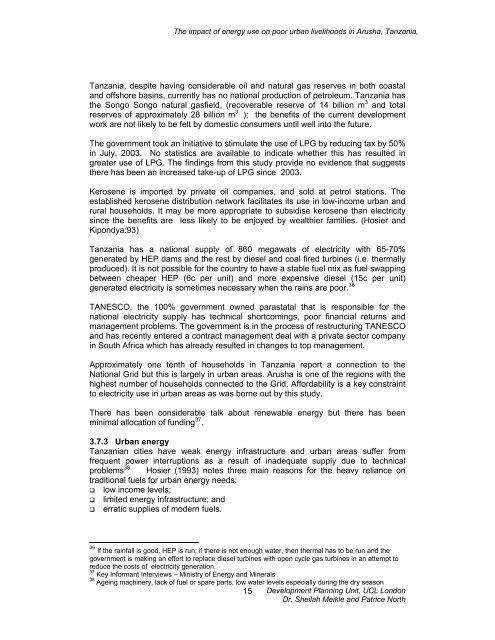The Impact of Energy Use on Poor Urban Livelihoods in ... - DfID
The Impact of Energy Use on Poor Urban Livelihoods in ... - DfID
The Impact of Energy Use on Poor Urban Livelihoods in ... - DfID
You also want an ePaper? Increase the reach of your titles
YUMPU automatically turns print PDFs into web optimized ePapers that Google loves.
<str<strong>on</strong>g>The</str<strong>on</strong>g> impact <str<strong>on</strong>g>of</str<strong>on</strong>g> energy use <strong>on</strong> poor urban livelihoods <strong>in</strong> Arusha, Tanzania,<br />
Tanzania, despite hav<strong>in</strong>g c<strong>on</strong>siderable oil and natural gas reserves <strong>in</strong> both coastal<br />
and <str<strong>on</strong>g>of</str<strong>on</strong>g>fshore bas<strong>in</strong>s, currently has no nati<strong>on</strong>al producti<strong>on</strong> <str<strong>on</strong>g>of</str<strong>on</strong>g> petroleum. Tanzania has<br />
the S<strong>on</strong>go S<strong>on</strong>go natural gasfield, (recoverable reserve <str<strong>on</strong>g>of</str<strong>on</strong>g> 14 billi<strong>on</strong> m 3 and total<br />
reserves <str<strong>on</strong>g>of</str<strong>on</strong>g> approximately 28 billi<strong>on</strong> m 3 ); the benefits <str<strong>on</strong>g>of</str<strong>on</strong>g> the current development<br />
work are not likely to be felt by domestic c<strong>on</strong>sumers until well <strong>in</strong>to the future.<br />
<str<strong>on</strong>g>The</str<strong>on</strong>g> government took an <strong>in</strong>itiative to stimulate the use <str<strong>on</strong>g>of</str<strong>on</strong>g> LPG by reduc<strong>in</strong>g tax by 50%<br />
<strong>in</strong> July, 2003. No statistics are available to <strong>in</strong>dicate whether this has resulted <strong>in</strong><br />
greater use <str<strong>on</strong>g>of</str<strong>on</strong>g> LPG. <str<strong>on</strong>g>The</str<strong>on</strong>g> f<strong>in</strong>d<strong>in</strong>gs from this study provide no evidence that suggests<br />
there has been an <strong>in</strong>creased take-up <str<strong>on</strong>g>of</str<strong>on</strong>g> LPG s<strong>in</strong>ce 2003.<br />
Kerosene is imported by private oil companies, and sold at petrol stati<strong>on</strong>s. <str<strong>on</strong>g>The</str<strong>on</strong>g><br />
established kerosene distributi<strong>on</strong> network facilitates its use <strong>in</strong> low-<strong>in</strong>come urban and<br />
rural households. It may be more appropriate to subsidise kerosene than electricity<br />
s<strong>in</strong>ce the benefits are less likely to be enjoyed by wealthier families. (Hosier and<br />
Kip<strong>on</strong>dya:93)<br />
Tanzania has a nati<strong>on</strong>al supply <str<strong>on</strong>g>of</str<strong>on</strong>g> 860 megawats <str<strong>on</strong>g>of</str<strong>on</strong>g> electricity with 65-70%<br />
generated by HEP dams and the rest by diesel and coal fired turb<strong>in</strong>es (i.e. thermally<br />
produced). It is not possible for the country to have a stable fuel mix as fuel swapp<strong>in</strong>g<br />
between cheaper HEP (6c per unit) and more expensive diesel (15c per unit)<br />
generated electricity is sometimes necessary when the ra<strong>in</strong>s are poor. 36<br />
TANESCO, the 100% government owned parastatal that is resp<strong>on</strong>sible for the<br />
nati<strong>on</strong>al electricity supply has technical shortcom<strong>in</strong>gs, poor f<strong>in</strong>ancial returns and<br />
management problems. <str<strong>on</strong>g>The</str<strong>on</strong>g> government is <strong>in</strong> the process <str<strong>on</strong>g>of</str<strong>on</strong>g> restructur<strong>in</strong>g TANESCO<br />
and has recently entered a c<strong>on</strong>tract management deal with a private sector company<br />
<strong>in</strong> South Africa which has already resulted <strong>in</strong> changes to top management.<br />
Approximately <strong>on</strong>e tenth <str<strong>on</strong>g>of</str<strong>on</strong>g> households <strong>in</strong> Tanzania report a c<strong>on</strong>necti<strong>on</strong> to the<br />
Nati<strong>on</strong>al Grid but this is largely <strong>in</strong> urban areas. Arusha is <strong>on</strong>e <str<strong>on</strong>g>of</str<strong>on</strong>g> the regi<strong>on</strong>s with the<br />
highest number <str<strong>on</strong>g>of</str<strong>on</strong>g> households c<strong>on</strong>nected to the Grid. Affordability is a key c<strong>on</strong>stra<strong>in</strong>t<br />
to electricity use <strong>in</strong> urban areas as was borne out by this study.<br />
<str<strong>on</strong>g>The</str<strong>on</strong>g>re has been c<strong>on</strong>siderable talk about renewable energy but there has been<br />
m<strong>in</strong>imal allocati<strong>on</strong> <str<strong>on</strong>g>of</str<strong>on</strong>g> fund<strong>in</strong>g 37 .<br />
3.7.3 <strong>Urban</strong> energy<br />
Tanzanian cities have weak energy <strong>in</strong>frastructure and urban areas suffer from<br />
frequent power <strong>in</strong>terrupti<strong>on</strong>s as a result <str<strong>on</strong>g>of</str<strong>on</strong>g> <strong>in</strong>adequate supply due to technical<br />
problems 38 Hosier (1993) notes three ma<strong>in</strong> reas<strong>on</strong>s for the heavy reliance <strong>on</strong><br />
traditi<strong>on</strong>al fuels for urban energy needs:<br />
� low <strong>in</strong>come levels;<br />
� limited energy <strong>in</strong>frastructure; and<br />
� erratic supplies <str<strong>on</strong>g>of</str<strong>on</strong>g> modern fuels.<br />
36<br />
If the ra<strong>in</strong>fall is good, HEP is run; if there is not enough water, then thermal has to be run and the<br />
government is mak<strong>in</strong>g an effort to replace diesel turb<strong>in</strong>es with open cycle gas turb<strong>in</strong>es <strong>in</strong> an attempt to<br />
reduce the costs <str<strong>on</strong>g>of</str<strong>on</strong>g> electricity generati<strong>on</strong>.<br />
37<br />
Key Informant Interviews – M<strong>in</strong>istry <str<strong>on</strong>g>of</str<strong>on</strong>g> <str<strong>on</strong>g>Energy</str<strong>on</strong>g> and M<strong>in</strong>erals<br />
38<br />
Age<strong>in</strong>g mach<strong>in</strong>ery, lack <str<strong>on</strong>g>of</str<strong>on</strong>g> fuel or spare parts, low water levels especially dur<strong>in</strong>g the dry seas<strong>on</strong><br />
15 Development Plann<strong>in</strong>g Unit, UCL L<strong>on</strong>d<strong>on</strong><br />
Dr. Sheilah Meikle and Patrice North
















